|
|
Post by codystarbuck on Mar 8, 2017 16:39:26 GMT -5
Innovation, like several publishers, tried licensed properties. They had success with some literary titles; but, they also went after some tv and film. One of the early ones they brought out and trumpeted was Lost in Space.      Lost in Space has a long comics history. Prior to the launch of the tv series, Gold Key came out with Space Family Robinson, with the same concept of Swiss Family Robinson in Space. They predated Irwin Allen and when the tv series launched, Gold Key decided to cut a deal, rather than sue. Their comic was retitled Space Family Robinson, Lost in Space, with the latter more prominently lettered and continued for several years. The comic outlasted the tv series, though it never actually adapted it. The Gold Key Robinson's weren't Allen's. Bull Mumy, who played Will Robinson, tried unsuccessfully during the 1980s to get Irwin Allen to back a revival movie, finishing the Robinson's journey. Innovation secured the licensing deal and Mumy came onboard to script (well, as a consultant, at first, then scripter on later issues) the comic, having been a lifelong comic fan and with a few comic book credits under his belt. He used the more serious tone of the original episodes; but, was less than happy with the overly sexualized images of the females (a common trait at Innovation). The comic was excellent and Innovation's top seller. Actor Mark Goddard got involved and the various actors' likenesses were licensed, giving it a faithful look. A romantic triangle was added with Judy, Penny and Don. A mini-series, called Project Robinson was launched to fill in the backstory of the family, with only the first issue, focusing on Maureen Robinson published, before Innovation went belly up. Mumy was also in the middle of a storyline, that would be completed several years later, in a trade collection, Voyage to the Bottom of the Soul. Here's a sample of the look of the series... 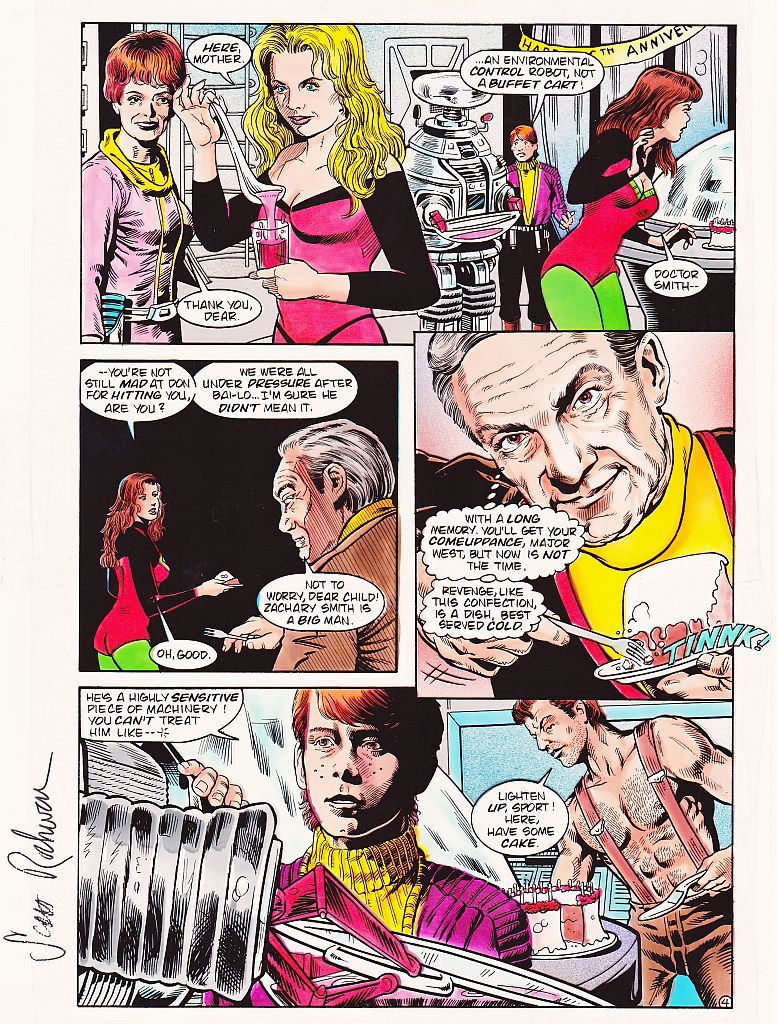 Here's the surviving cast with the comics... 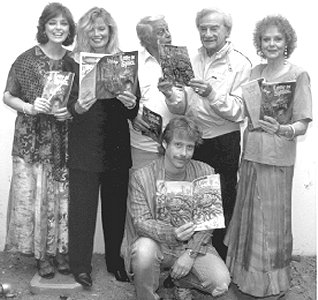 Innovation also licensed the then-new revival of Dark Shadows, with Ben Cross as Barnabas Collins.   These also did fairly well, drawing fans from outside of comics.    The popular Beauty and the Beast, with Ron Perlman and Linda Hamilton was also licensed. Innovation also grabbed movie licenses, with Forbidden Planet...   adapting the film into comics, which was later collected into a trade..  With the Rocketeer due to hit theaters, Innovation tried to ride the perceived success (boy were they wrong) by adapting the Republic movie serial that inspired it, King of the Rocket Men.     The mini featured writing and gorgeous painted art from Christopher Moeller, who would go on to success with his own Iron Empires stories (Faith Conquers and Sheva's War), as well as JLA: A League of One. Moeller expanded upon the serial and updated some of the technology, to make it more fantastic. The Rocket Man was given a rail gun and the series ends with the hero, Jeff King, working for the government, leading an entire army of Rocket Men against America's enemies. The series was later collected by Caliber. Innovation went into horror, with Child's Play, A Nightmare on Elm Street and Psycho...      Innovation had one other media tie-in that was also hugely popular      The series was very well done, capturing the feel of the series, in new stories. There was a nice mix of human drama and humor, just like the show. Everyone involved in the tv show supported the comic and it proved popular among fans of the series, including those who didn't read comics. As such, they command higher prices on the market. One issue in particular was a direct sequel to an episode...  The second season episode, "Goodnight, Dear Heart." features Sam leaping into a mortician who solves the murder of a young German immigrant woman, who was killed by her lesbian lover, when she left her for a man. Many in the gay & lesbian community were unhappy with this episode, as they felt it tread upon old pulp stereotypes of gays and lesbians as unbalanced people, prone to violence when spurned (a feature of a lot of pulp fiction). Andy Mangels, a comic fan and entertainment journalist, and also a gay man and activist, took issue with the episode and decided to do something about it. He wrote a sequel, where Stephanie Heywood, the killer, is released from jail and tries to move on with her life, in New York. While in prison, she took photos of women prisoners and became the darling new sensation of a New York art patron. Upon her release, she is whisked to New York and enters the art world, being pulled from serious subjects into the fashion world, by her patron. She is approached by a lesbian organization, The Daughters of Bilitis (founded in 1955), which seeks to improve gay rights, especially women. Stephanie, or Stephiana, also meets Clarice, a model who becomes her subject in fashion shoots. It turns out that Clarice is actually a drag queen, who says the world isn't ready to have a drag queen super model (until RuPaul) and asks Stephanie to keep the secret. Later, Sam receives a phone call and rushes to the police station, where Clarice has been bailed out, after being brutally beaten. It turns out she was beaten by the police, as part of regular shakedowns of gay clubs. Sam/Stephanie decides to finally take a stand and takes photos of Clarice, sans make-up, with bruises and contusions on display, in fashion poses, showing the world what was done. The story culminates into the night/morning of June 29, 1969, when the gay community had enough and the Stonewall Riot erupted. Sam's knowledge of history allows Stephanie to be in a position to shoot amazing photos of the riot, which will light the fire of the LGBT civil rights movement. 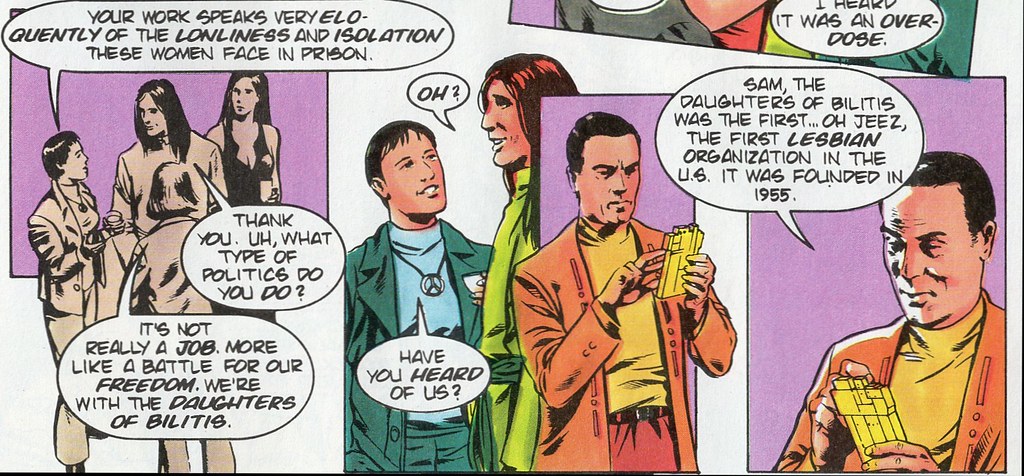 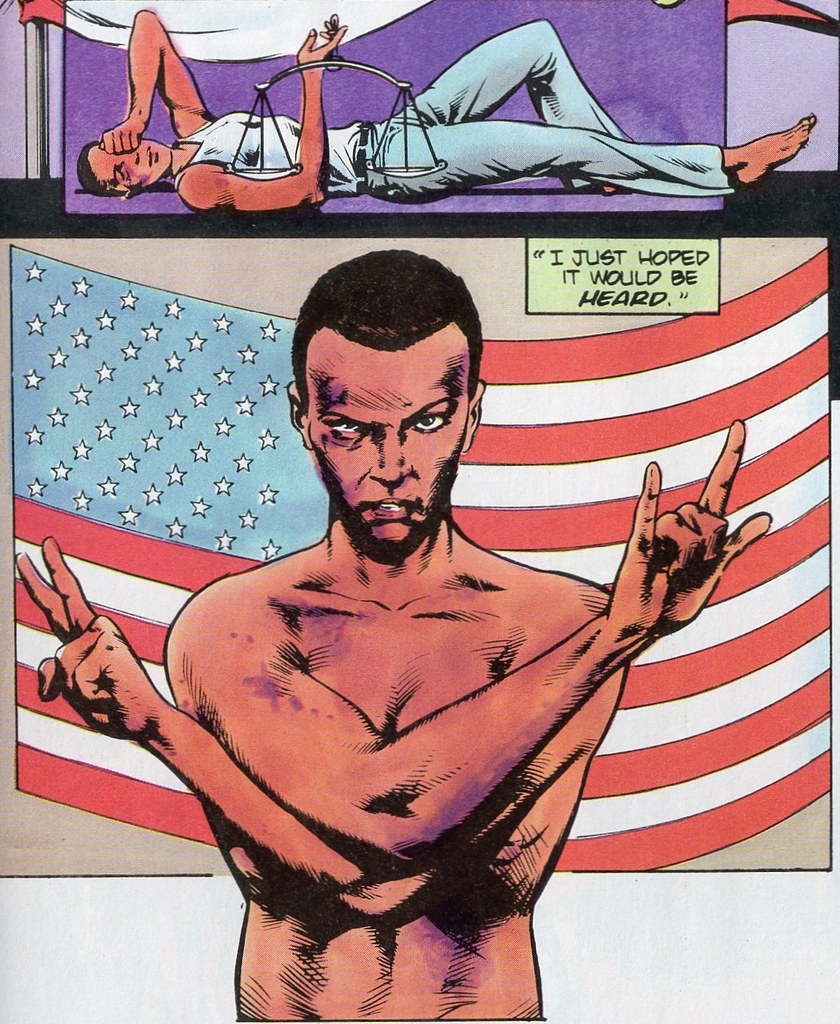 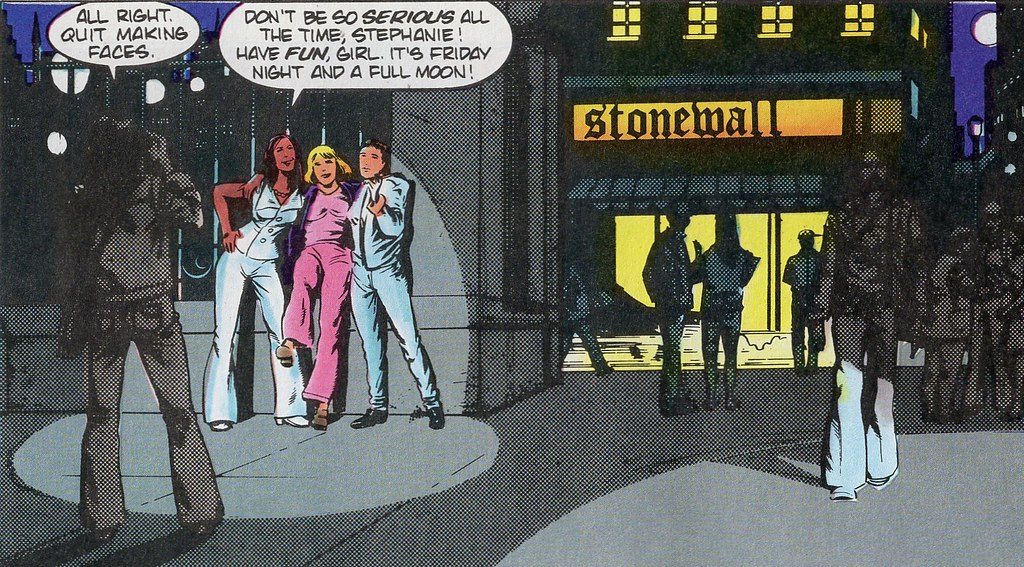 Andy Mangels wrote an essay about the state of LGBT rights, at a time when several states had ballot issues that would restrict rights and compared it to 1969.  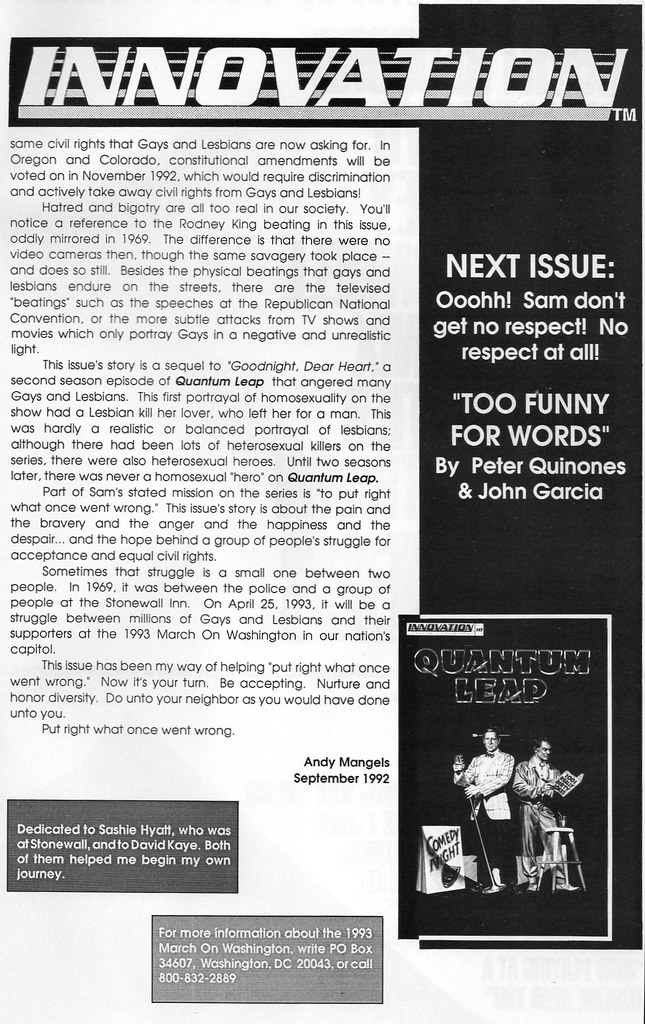 It was a courageous stance by Mangels and it was a courageous act to publish the issue, for a commercial comic book publisher, with the full support of the production company. They recognized that they had done wrong in the previous episode and this helped set it right, Sam's function in the series. They also followed up with the episode, "Running for Honor," where Sam leaps into a gay military cadet. This is an extremely powerful issue and serves both as a great Quantum Leap comic and a tool for education. I loved the series and was picking up the comic and it struck a nerve. I'm a heterosexual male; but, I saw too many good people forced out of the military because they were gay (before Don't Ask, Don't Tell). When I began working for Barnes & Noble, many of my colleagues were openly gay, as were some of my closest friends, including one who wasn't out with his family, but became so, due to abrupt circumstances. I learned a lot from those friends and from people like Andy Mangels, who set out to show the injustices done and a better way forward. I wish there was a trade collection of the series available, so that this story was more readily available to the public. The series went off the air while the comic was still going and there was a proposal to do one of the stories that the tv show couldn't do, from an effects budget standpoint: Sam leaping into a baby. The issue was announced and solicited, when Innovation finally caved under their debt. It's a shame, as it was the perfect medium to handle the concept, on a small budget. Next up, some original material from Innovation. |
|
|
|
Post by Rob Allen on Mar 8, 2017 18:34:38 GMT -5
Mangels lives here in Portland and I've met him a couple of times, but I've read very little of his work. Thanks for bringing this to my attention!
|
|
|
|
Post by codystarbuck on Mar 8, 2017 19:44:42 GMT -5
Mangels lives here in Portland and I've met him a couple of times, but I've read very little of his work. Thanks for bringing this to my attention! Here's Andy's Wikipedia page: en.wikipedia.org/wiki/Andy_MangelsI first came into contact with his work in the fanzine world, in places like Amazing Heroes, Comic Scene, Back Issue and the Comic Buyer's Guide. He's written some Star trek comics, Boba fett, Justice League Quarterly and Wonder Woman '77 (including Wonder Woman '77/Bionic Woman). Andy has also written about media properties and has been featured on several dvd collections for things like He-Man, Flsh Gordon and other Filmation properties, both on camera and creating features behind the scenes. |
|
|
|
Post by codystarbuck on Mar 12, 2017 15:18:47 GMT -5
So, I;ve talked about Innovation's licensed books, their literary adaptations, and the Hero Alliance, while previously talking about Justice Machine and Maze Agency; what else did they have? Well, they continued legends of the Stargrazers, which premiered a few years before In Vanguard Illustrated, at Pacific.     Do I really need to spell out the appeal of this series? The Adam Hughes covers were not matched with Hughes interiors, as he couldn't handle that much work (and he wasn't doing that much with Maze Agency, by that point). Actually, the stories weren't quite that blatantly titillating, though they weren't a massive improvement. Innovation was notorious for a lot of T & A, though nowhere near as bad as the Bad Girl fad that followed. Stragrazers did have some fun going on in the book; but, it came in a rather juvenile package.       Cyberpunk was from Scott Rockwell and Darryl Banks (initially, though others came onboard, later). It's pretty much what the name says, a typical cyberpunk story of a hacker, evil corporations, drugs, gangs, noirish settings. In other words, Blade Runner meets computer geek fantasies. Cyberpunk was hot, with the writings of William Gibson, Neal Stephenson, and bruce Sterling. Quite frankly, most of that stuff bored the heck out of me. The relentless jargon never helped and the comic is filled with that. however, if you enjoyed those works, Cyberpunk might be up your alley. The art is pretty good, with a mixture of painted work and graphic design. There's a lot of stuff inside the gameworld that's all very Tron.    Power Factor was another superhero book carried over from Pied Piper/Wonder Color, like the Hero Alliance. It was also from Kevin Juaire, who developed Hero Alliance, though Bob Ingersoll (Wolf & Byrd) came on board to script it). It's pretty lightweight, with some amateurish art, and a surprising appearance by Carmine Infantino. Only for the curious.  Ack the barbarian is a Groo wannabe, from Mario Macari. That pretty much covers it. Need more? Well, the artwork looks like it came out of a high school notebook. "Nuff said!      Angry Shadows was a one-short horror anthology, with black & white interior. It wants to be Warren; but isn't the same level of craftsmanship. Stephen Niles has an early story and the cover is John Bolton, which probably sold more copies than anything else. Avenue X is kinky vampire stuff, ala Anne Rice and Laurel k Hamilton, based on (of all things) a radio drama. It's mostly an excuse for cheap T & A and girl-on-girl action. Alex Nino's Nightmare is a fantasy/supernatural one-shot, from the master. It's more a visual exercise than anything else, which is mindboggling. Bruce Jone put out two one shots of material. It's pretty much the same kind of thing as Alien Worlds and Twisted Tales, except that it is Jones writing and drawing, not just collaborating. Some good stuff here.  Headman is a weird space opera tale of a man who is reduced to a disembodied head, a female doctor who loves him, and a rebellion. If that's not enough, there is a love scene between the woman and the head. No, I'm not going to touch that statement with a ten foot pole. It's not quite Futurama; but, it is goofy. Creator Matt Thompson also did art on Legend of the Stargrazers.  Bozo was a reprint of some old Bozo comics, though it isn't stated as such anywhere inside. However, everything looks like the 1940s. Innovation took some flack for reprints that weren't labelled as such, though that was more about some repackaged specials, where they slapped new covers on existing material. This looks like a straight-on reprint, with new coloring. I don't know who the market was for this, apart from the Boomer comic collectors or Bozo fans, who probably had the old comics. Bozo wasn't exactly a media sensation in 1992, though he was still on WGN, weekdays.   Torchy was reprints of old Bill Ward material, with new covers by Olivia de Berardinis and others. It was more T &A, from a company that had a rep for it. However, Torchy was pretty tame stuff, though some of the racier stuff Ward did in the Army was reprinted. Even that wasn't that racy.  Straw Men was a sci-fi/horror series, about atomic experiments and a community affected by it. it was black & white, with less than polished art. Quite frankly, it looked more like the sort of thing Malibu published, under its various imprints (Aircel, Eternity, etc...)    Timedrifter was from gerard Jones and featured a guy who feels out of time, longing to be part of the Golden Age of Hollywood and 1930s adventure. Well, with a bit of time travel, he gets his wish and ends up on a nostalgic joy ride. This is more black & white, with decent art, that gets by mostly on charm and some fun.  Celestial Mechanics isn't Love & Rockets. It's a bit of space opera T & A, in B & W.  Scaramouch has nothing to do with Raphael Sabatini or the Comedia del Arte; it's a bizarre punk story with zombies and Nazis and general weirdness. It was a little out of my zone.   Newstralia was created by Stephen Sullivan and Tim Truman (though Truman's involvement is extremely limited), featuring a post-apocalyptic sci-fi story, set in Australia. There are mutant kangaroos and the like, flying craft, guns and scantily clad women. It's about a C-level book, occasionally a B; but, Tank Girl it ain't (nor Mad Max). Innovation had a few other books; but, I'm not as familiar with them. All things considered, Innovation was a decent little company, whose ambitions overtook their resources. They tried to innovate (pun intended) by creating comics on CD-Rom; but, the market wasn't there and development costs were high. They were also plagued with having to use young, under-developed artists, who moved on when their work improved enough to get a higher paying gig. They did have a pretty good line of licensed titles, paving the way for companies like Moonstone and Dynamite, who live on that stuff. |
|
|
|
Post by mikelmidnight on Mar 17, 2017 12:19:07 GMT -5
Hero Alliance was a reasonably-done series, but I had trouble connecting with their 'universe' and the stories weren't QUITE good enough to get me over that hump.
Ironically, I loved the idea behind The Protectors (revival of the Centaur heroes) but didn't much care for the actual stories. I've always wished Hero Alliance and The Protectors had switched creative scenes!
|
|
|
|
Post by codystarbuck on Mar 18, 2017 19:22:04 GMT -5
Hero Alliance was a reasonably-done series, but I had trouble connecting with their 'universe' and the stories weren't QUITE good enough to get me over that hump. Ironically, I loved the idea behind The Protectors (revival of the Centaur heroes) but didn't much care for the actual stories. I've always wished Hero Alliance and The Protectors had switched creative scenes! Well, that's the thing; you had a revolving door of creative teams. hero Alliance was a little more consistent, since Dave Campiti had been involved since the start. The Protectors was a nice concept; but, it seemed like they didn't have much of a story in mind. It didn't help that the early covers and concept art, used to market the series, were done by Clarke Hawbaker and Jerry Bingham. Then, when the series came out, you had a much less polished artist on the interior art. |
|
|
|
Post by codystarbuck on Mar 20, 2017 23:00:37 GMT -5
This is mostly a preview of what is to come. I haven't updated for a few days, as I had my grandkids for the weekend, and spent time preparing for their visit and entertaining them. The reviews will pick right back up. This time, we will spend some more time on individual titles, as I want to explore one of my favorite independent companies: Eclipse Comics.  Eclipse was founded in 1977, by Jan and Dean Mullaney, as Eclipse Enterprises. it started on the East Coast; but, eventually headed west, ending up in California. That would end up having a significant impact on the company. Eclipse published the first graphic novel sold via the Direct Market distribution system, with Sabre, in 1978. Its success paved the way for others and also showed establish pros that there was a source of income outside of the Big Two. Eclipse followed that up with an anthology magazine, Eclipse Magazine, and a color comic, Eclipse Monthly.     Many more comics, graphic novels, trade collections, trading cards, t-shirts, and record albums (yep, record albums) would follow. Eclipse also acted as a historian, reprinting pre-code works, as well as retrospectives of various creator's works. They were also very politically active, with comic pieces in their magazines about students' rights, topics such as nuclear proliferation, and via publications like Brought to Life and Real War Stories. They championed comics from around the globe, reprinting British comics, including Miracleman and Laser Eraser & Pressbutton; and were one of the earliest manga translators, with Mai the Psychic Girl, Kamui the Ninja, and Area 88. They helped carry on other books from defunct publishers, like Pacific. They showcased a lot of young talent, including Eric Larson, Tim Truman, Stan Woch, Tom Yeates, Tom Lyle, Scott McCloud, Dan Brereton, Kurt Busiek, Terry Beatty, and Chuck Dixon. They gave unfettered support to established pros, like Don McGregor, Steve Gerber, Jack Kirby, Paul Gulacy, P Craig Russell, Alan Moore, Neil Gaiman, Dan Spiegle, Doug Wildey, and Gene Colan. They brought in people from fanzines and undergrounds, like Michael T Gilbert, mark Evanier, and more. One of the secrets to Eclipse's early success was via back issues. Marvel (especially) and DC did their darndest to flood the direct market with reprints; so, smaller publishers scrambled for space. Eclipse offered mail order services for customers and kept a supply of back issues to help new fans catch up on titles and discover others. This brought them cash which was then used to fund new publications. This worked well until 1986, when a large flood destroyed most of their back issue stock, in their California warehouse. Eclipse was never the same after that. Their cash flow suffered heavily and there were frequent delays in publication, due lack of funds to pay the printers (and lack of credit, due to bounced checks). The James Bond mini-series (3 issues) that Mike Grell created took a year and a half to come out, despite having all of the artwork in house on time (per a conversation I had with Grell). The situation grew worse as the company entered the 90s, though they had successes with trading cards, including the infamous serial killers cards, which were targeted by activists. However, it took time for that money to come in and losses mounted. The final nail in the coffin was the divorce of cat yronwode and Dean Mullaney, which revealed how bad the money problems were, as well as added to acrimonious relationships with creative talent. Eclipse ceased publishing in 1994, and formally filed for bankruptcy in 1995. Despite much higher offers for particular properties owned or co-owned by Eclipse, the bankruptcy court ruled in favor of an offer put forth by Todd McFarlane, who obtained all rights held by Eclipse (apart from creator owned books and licensed material). It is believed his interest was largely built around Miracleman, though Beau Smith was working for McFarlane, at the time, and may have had ideas for some of the other characters (like Black Terror, which Smith co-wrote). This led to the long-standing legal battle over the Miracleman rights, which was only recently settled in favor of Marvel, after they purchased rights held by Mick Anglo, the original UK creator. Next, I will be going into some detail on a few key Eclipse titles, while peppering things with a few capsulized reviews of some of Eclipse's lesser-known works. I will probably focus on storylines, more than individual issues, though I may highlight a few specific issues. First up: Tim Truman's Scout and the 4-Winds (Truman's studio)-produced Airboy; plus, a miracle arrives in a crash of thunder and lightning.  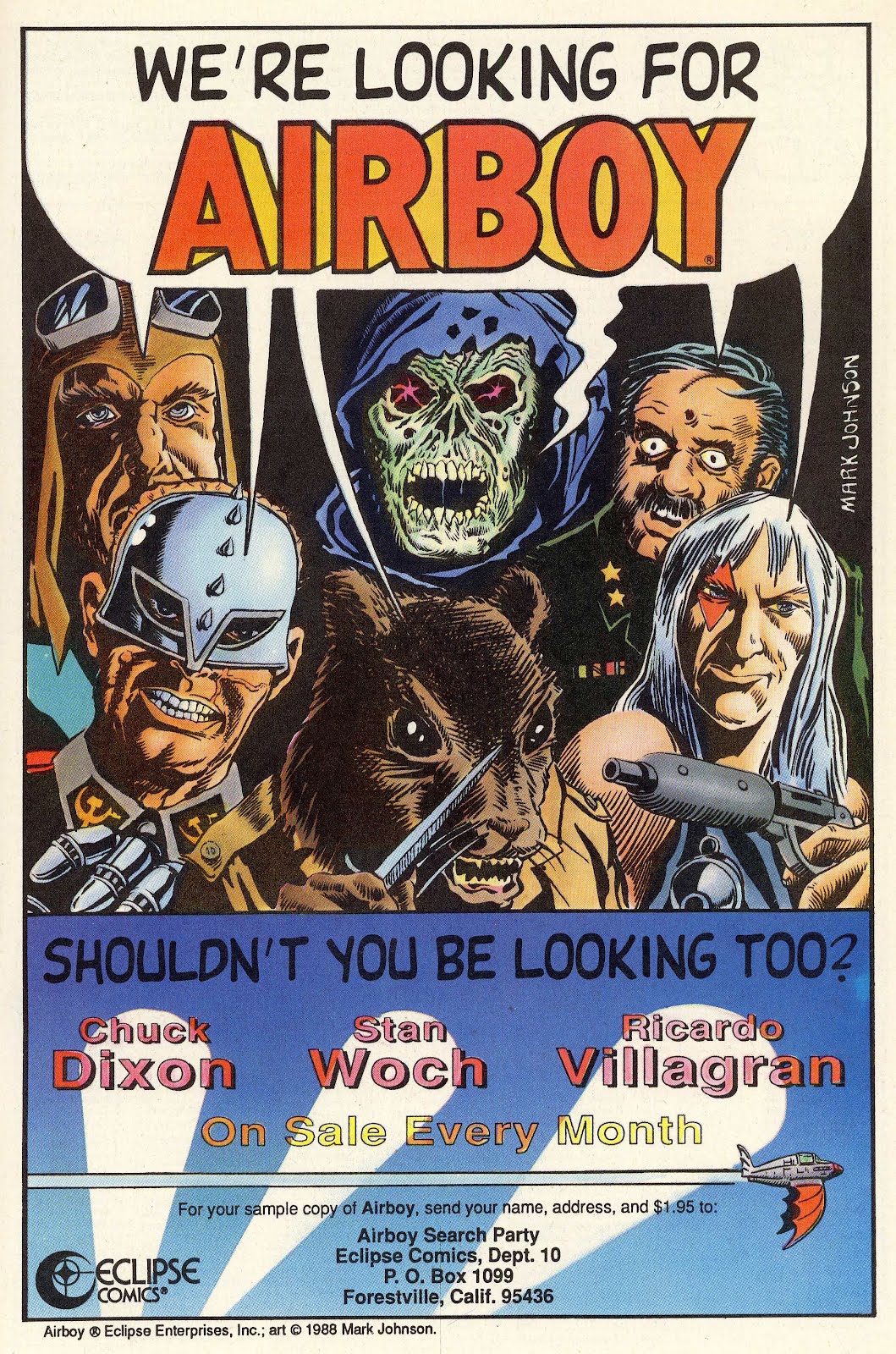 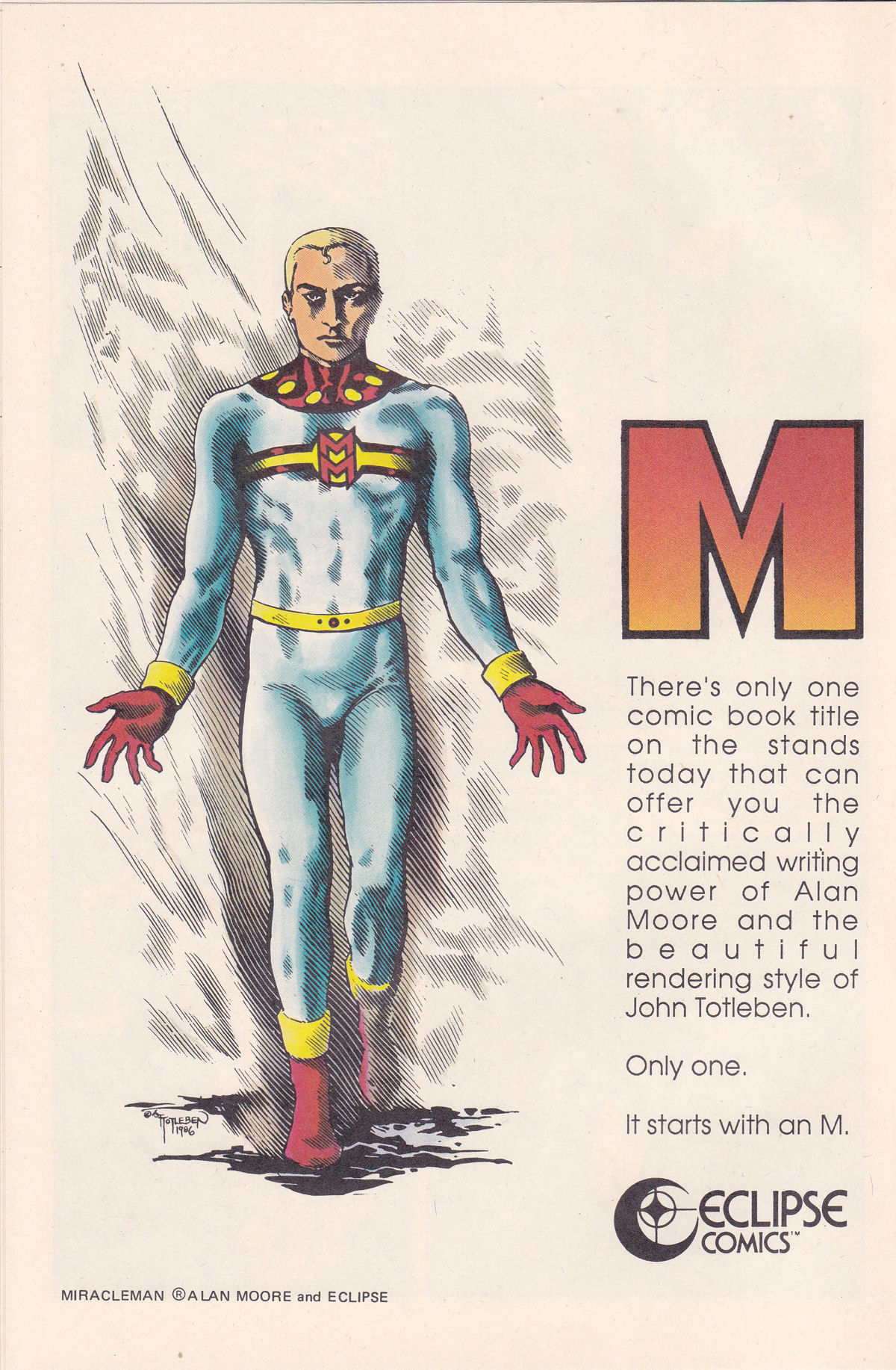  |
|
|
|
Post by hondobrode on Mar 20, 2017 23:18:45 GMT -5
I'm way behind of this excellent thread, but I liked a lot of Innovation, though they're not easy to find.
Eclipse had some different stuff, notably Marvelman / Miracleman.
One of my earliest indie purchases was the outstanding P. Craig Russell (need I say more ?) Night Music.
I'm sure that will be covered along with lots of other stuff.
You schooled me here codystarbuck, as I had no idea Eclipse started on the east coast.
|
|
|
|
Post by codystarbuck on Mar 21, 2017 9:49:22 GMT -5
I'm way behind of this excellent thread, but I liked a lot of Innovation, though they're not easy to find. Eclipse had some different stuff, notably Marvelman / Miracleman. One of my earliest indie purchases was the outstanding P. Craig Russell (need I say more ?) Night Music. I'm sure that will be covered along with lots of other stuff. You schooled me here codystarbuck, as I had no idea Eclipse started on the east coast. Eclipse's first location was on Staten Island; they then moved to Columbia. Mo and then to California (Guerneville, then Forestville). I believe (but can't confirm) they were located in Guerneville when the Russian River flooded out their warehouse, destroying the bulk of their backstock. I actually knew someone who worked (briefly) at Eclipse. A family friend, David Allen, used to assist cat yronwode and handled some of the letter columns. He was somewhat known in fan circles. I actually hadn't seen him since we were kids (our parents had been school teachers together, until his parents moved), even though he was also at the Univ. of Illinois, when I was (he was older and was finishing up when I started). I believe he had been studying to be a journalist, which helped lead to the gig. he wrote the Campus Scout column for the school paper, the Daily Illini, a column which had once been written by a young Roger Ebert. |
|
|
|
Post by codystarbuck on Mar 22, 2017 15:59:38 GMT -5
Okay, set your wayback machine for 1985. Ronald Reagan has won a landslide re-election, Rambo is back and single-handedly wining the war in Vietnam (after the fact), Jerry Ahern's Survivalist book series is on the paperback racks, and post-apocalyptic visions are a favorite in sci-fi and film, especially things like Mad Max 2, aka The Road Warrior. Into this climate came a comic about a rogue soldier, in a fractured US, with ecological disaster, a fascist government, decay and corruption. Sounds pretty generic, right? Just another comic jumping on a trend. Except, Tim Truman isn't someone who just jumps on bandwagons. Said rogue soldier is an Apache, who has visions of the 4 Monsters of legend, and whose spirit guide is a chipmunk.        The series opens with a striking drawing of a cactus bloom and a skull, as excerpts from Rosana Winter's memoirs fill in the backhistory. The next few pages are like a Sergio leone western, if Clint Eastwood was a Native American. A pair of rednecks are sitting around a desert gas station when a lone man rides in on a motorcycle. We hear racist comments as the man fills up his tank, ignoring the owner telling him he has to pay in advance. One of the rednecks tries to press matters and the poncho clad figure, throws one end over his shoulder, revealing heavy duty firearms. 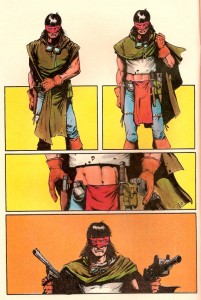 Pure Eastwood, pure Leone! Except this gunman kills a bear, lurking behind a screen door, mad with hunger. We have been introduced to Emanuel Santana, Scout. Truman picks up the story in the desert, as Scout stops and undergoes rituals with peyote and has a vision of the Gahn, his spirit guide. He first appears as a katydid and spends more time mooching food off the rather POd Santana. Scout has been plagued by dreams and wants answers, and he gets it. he has been chosen by Usen, the great spirit, to slay the four monsters who plague humanity. Oh, and it isn't a job offer, it's his destiny. Scout ends up at a ranch, owned and operated by a pornographer and pimp, named Al. Scout makes his entry with a grenade and breaks up the party and faces Al, who he sees as the White Owl Giant. He kills the monster, rescuing a young girl named Missy, in the process, then sits waiting, with the gahn, now a chipmunk, eating again. His wait ends when the Secretary of Agriculture shows up to see who messed with the operation that served people of power and influence. Words are exchanged and a war begins. Santana rides off into the desert, with Missy and the Gahn. That opening issue gives you everything: a Clint Eastwood heroe, mixed with Native American mythology. His artwork is sparse, but effective, matching the desert locales. There is a harsh beauty to the whole thing, a beauty marred with quick violence. Like Max, this is a warrior in search of a war and it has found him. Truman was already making a name for himself on Grimjack and was one of the first batch of graduates from the Kubert School. His work had a gritty realism that spoke of the influence of Kubert and some of the other artist who taught at the school, as well as some of the classic illustrators. Scout let Truman show his writing chops, which were pretty strong, right from the start. Meanwhile, it's not all grim. Truman had a sense of humor and it filters through the series, especially in the scenes between the Gahn and Santana. The choice of a katydid as the first manifestation is likely deliberate, as Jiminy Cricket jokes abound in the series and later sights of Santana with a chipmunk on his shoulders, as he faces off against the White Owl Giant are rather comical, if not surreal. Later, we will get the awesome addition of Beau La Duke, though that is for another time. The second issue sees Scout on the run from the Army, including (appropriately) Apache gunships, as Truman (via Santana's narration) brings up the history of the US wars against the Apache, where success came by setting other Apache to root out the rebels. Truman plays with a bit of metaphor for the then-ongoing war in Afghanistan (after the Soviet invasion), as Scout destroys a gunship with a rocket launcher. he and Missy and the Gahn set off for Houston and run into an agricultural station. Soil in the US is depleted and this farm is using chemicals to grow food, further polluting already vulnerable soil. Scout destroys the operation and kills the second monster, Ag Aec. Waltz, aka The Buffalo Monster. Meanwhile, Pres. Jerry Grail (ex-pro wrestler turned politician) consults with advisor Bill Loper (an African-American evangelist) about the situation and we are introduced to two Army Rangers, Sgts Rosanna Winter and Ray Vaughn. They know Santana from training and are tasked with hunting him down. Turns out, all were taken into the Army as teens, trained and indoctrinated and turned into soldiers/killers. Santana rebelled and went AWOL. Oh, and Rosanna had a relationship with him. 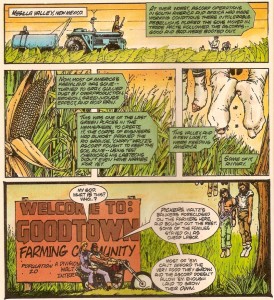 Truman further builds this world, showing the ecological disaster that has devastated the country and the corrupt nature of the government. The idea of a performer turned president echoes Reagan, replacing B-movie actor with professional wrestler (which was red hot, in 1985). Add an evangelist and you will get Truman's views on some of their ilk. Issue 3 sees Scout and Missy entering Houston, a decayed city, plagued by gangs and violence. There, Scout meets Guitar Man, a Fender-toting gang member, who also carries a few guns. He also meets a preacher, Rev. CW Deluxe, who runs a camp for displaced people, who takes them in and feeds them. He is aided by a mentally handicapped boy, named Doody, who spouts a mixture of scripture and Tolkien. We also meet Vice President Laura Carver, a heroin addict who is being kept compliant and under wraps by Bill Loper. The Army moves in on the camp, led by Winter and Vaughn and Scout and Vaughn renew old hostilities, while Scout and Winter face off, leaving us to wonder if love is still there. Issue 4 sees Scout fight the Eagle Monster, in the form of Energy Sec. Eagre. Eagre attacks Scout in a P-40M Kittyhawk III fighter (as the Gahn informs us) though some quick work by Santana and a motorcycle send it to its doom. meanwhile, Scout tells Rev. Deluxe that the power to defeat the monsters demands a sacrifice and someone will die. Rosanna Winter is blamed for the failure to catch Scout and is assigned as a bodyguard to Laura Carver. Vaughn, who is healing, is assigned to security. By the end, Vaughn has captured Doody and demands Scout come to him. Issue 5 sees Scout, Missy and rev. Deluxe go after Doody, who is being tortured, including having his eyes cut out. Scout infiltrates the location and is able to get Doody out, at the cost of Deluxe's life. meanwhile, we learn about Laura Carver and Rosanna helps her find the strength she once had to try and fight against Grail and her keepers. This all builds to the climax, in issue 6. Issue 6 sees Santana face the Antelope monster, the final of the four. Rosanna is forced to make a choice between helping Laura Carver and Scout or following orders, a choice that puts her at odds with Ray Vaughn. It's a powerful piece that brings an end to the first book, which is dedicated to John Ostrander. Issue 7 acts as a coda to the saga of The Four Monsters. We learn about the pasts of Rosanna and Santana, how they met at Camp Falwell, as part of a group of poor teens (most minorities) who were rounded up to be re-educated and trained as soldiers. Santana and Rosanna become lovers; but, Santana rebels and decides to leave, with Ray Vaughn and Rosanna confronting him, while on guard duty. Rosanna lets him go, which informs her torn loyalties we saw in previous issues. The art is from friend Tom Yeates, a fellow Kubert School graduate. All along the way we see Truman's mix of gritty urban fighting and western desert, a decaying land and a corrupt system. All of this had great resonance in the 80s, as the US was "covertly" backing wars in Central America and Afghanistan and confrontation felt inevitable. Much of the politics of the era inform the series, as well as the events and politics of the Vietnam era. We also see Truman's love of Blues music and rock 'n' roll. Santana is named for Carlos Santana and Ray Vaughn is named and modelled after Stevie Ray Vaughn. Guitar Man is a mix of Jimi Hendrix and Miami Steve Van Zandt. The issue titles were generally taken from old Blues songs. Ecology is a major theme throughout, as is corruption, oppression and rebellion. Artistically, Truman reads as a mix of an urban graffiti artist and western painter; kind of Banksy-meets-Remington, with more than a bit of Joe Kubert and Russ Heath thrown in. The saga was collected into a trade by Eclipse and later reprinted by Dynamite, with new coloring. The artwork alone is something you rarely see in comics these days, as it is filled with classic techniques. Truman draws great desert vistas, dark urban environments, and everything in between. He is adept at facial expressions and body language and lets the art tell the story when it should, while adding personality and detain via the dialogue. This was a fantastic start to one of the most intriguing and unsung series of the 80s (though it had some decent fan press, in the day). People now know Truman more for his work with Star Wars and Conan, as well as his DC work on Hawkworld and Jonah Hex. If you enjoy any of that, you really owe it to yourself to see Scout. Next, we move onto Book 2, where Scout runs into an entirely different threat, one that hits close to home. |
|
|
|
Post by codystarbuck on Mar 22, 2017 17:00:33 GMT -5
One of the things Eclipse did well was adventure comics, particularly those in a classic vein. One of the best was Airboy.      Airboy and the characters of The Heap and The Airfighters had all been published by Hillman, back in the 40s. Airboy was their most popular character, a mix of Terry & the Pirates and aviation pulp adventure. The story revolved around a young man who grows up in a monastery and gains a legacy from one of the brothers, who created a fantastic flying machine, Birdie. With it, Airboy took on crooks and Nazis, as he soared through adventures during and after WW2. One of his most popular adversaries, mirroring the Pat Ryn and Dragon Lady relationship, was Valkyrie, a female German pilot. Valkyrie and her Airmaidens often found themselves opposing Airboy; but, she was attracted to him and eventually switched sides. Airboy also fought against a monster, known as Misery, who flew an Airtomb, with the souls of lost aviators. He sought Davy Nelson's soul and would do anything to get it. Along with Davy Nelson, Airboy, Hillman's Airfughters comics featured Skywolf, a sort of Blackhawk rip-off, with a hero with a wolf pelt draped over his head. There was the Flying Dutchman, a pilot who was fanatical in his attacks on the Germans. The Bald Eagle, a haphazard pilot. iron Ace, a British pilot who flew in a suit of armor. There was the Black Angel, a female British pilot who fought the Germans. Eclipse realized that these characters were lying unused and had fallen into the public domain. They quickly published a special that was included in several comics that introduced the characters. Then, Chuck Dixon and Tim Truman started up a new bi-weekly series. The series was set in the present day, as Davy Nelson is now the head of his own aviation and weapons conglomerate. He is seen being menaced by a hooded figure, blackmailed into selling arms to a fictional latin American dictator, of the nation of Bogantilla. Nelson's home is attacked and he is killed, but his son escapes, with the help of Hirota, a former enemy of the original Airboy. Young Davy Nelson finds help from the fighter pilot turned mercenary Sky Wolf, who is living on an old airfield; but, ho just happens to have an Apache gunship. They trace the killers to Bogantilla and find themselves caught up in a revolution and Misery's schemes. It turns out Misery was blackmailing Davy Nelson Sr, holding the dormant Valkyrie as a hostage. Young Davy and the Airfighters free her, with the help of the Heap, the first swamp monster of comics, whose body houses the soul of WW1 German pilot Baron Immelman, who crashed into a swamp, in what was later Poland. He was revived as the muck-monster. The series is a great mixture of pulp storytelling and action-adventure movies, mixing Rambo-esque action with rat monsters and supernatural creatures. As the series progressed, Davy pulled Nelson aviation out of the weapons business and faced new threats. there were German werewolf pilots, a Soviet agent (Steel Fox), and a return of Misery, in an epic climax to the series. Along the way, Chuck Dixon crafted a pulp world of adventure that was one of the most exciting comics on the stands, if you could find it. The Airfighters were spun off in specials and even reprints of some of the Hillman stories. The bi-weekly experiment ended and Airboy gained back-up stories with Sky Wolf, as we follow his adventures after WW2. Along the way he ends up in Korea, Guatemala (during the CIA's overthrow of the democratically elected Arbenz government), Hollywood, married life, and Indochina, where he encounters his old enemy Baron Von Tundra, serving with the French Foreign Legion. Skywolf and the Bald Eagle are there hunting treasure and end up in the middle of the Battle of Dien Bien Phu and as POWs.    Airboy was at its best when it stuck to the pulp stuff. Airboy ended up fighting the Soviets in Afghanistan and the end result isn't quite as good. The early issues are the strongest of the series, though the final storyline, detailing how Valkyrie became a prisoner of Misery and the final attempt to end Misery's existence returned the series to its heights, mostly in time to be ignored by an indifferent market. The Skywolf back-up stories were some of the best elements, from the time they begin, up through the mini-series. Skywolf became a tour through post-war American history and what happens to an adventurer when he tries to settle down to everyday life. It was far more successful at this than DC's attempt at reviving Blackhawk, with Marty Pasko. Worth checking out are the Valkyrie miniseries, with Paul Gulacy art (on the first one), where Valkyrie faces charges of war crimes. Actually, all of the Air Fighters and Air Maidens specials are worth reading, as is the crossovers with Sgt Strike, the Adolescent Radioactive Black Belt Hamsters and Mr Monster. All good pulpy adventure and fun.      |
|
|
|
Post by wildfire2099 on Mar 22, 2017 21:15:54 GMT -5
I really like Airboy... I have the recent collections.. it's very much a product of it's time, but that actually adds to the charm for me.
|
|
|
|
Post by codystarbuck on Mar 23, 2017 6:59:54 GMT -5
I really like Airboy... I have the recent collections.. it's very much a product of it's time, but that actually adds to the charm for me. Yeah, it certainly reeks of the 1980s; but, in a good way. Given that the era was dominated by X-Men, Crisis on Infinite Earths, and Dark Knight, an aviation pulp adventure stood out as something different. It certainly fit into the world of 80s action movies, as you could see John Milius directing an Airboy movie (or Sky Wolf). Of course Eclipse made the Heap prominent in their marketing, so they could ride the coattails of Swamp Thing, while pointing out that The Heap came first (after Theodore Sturgeon's "It"). |
|
|
|
Post by Deleted on Mar 23, 2017 14:32:56 GMT -5
I read some Valkyrie and Airboy from Eclipse Comics and I find them to be adventurous, exciting, and dynamic and both of them provide me tons of entertainment value in the 70's and they were the only Eclipse Comics available to me at the time and I've foolishly gave them away after reading them 5-6 times before discarding them to my friends for peanuts!
Drats!
|
|
|
|
Post by wildfire2099 on Mar 23, 2017 20:53:29 GMT -5
Yeah, the Heap is interesting... you wouldn't think a swamp monster would fit into a retro-ace fighter comic set firms in the 80s socio-political climate, but it totally did.
|
|




































































































































